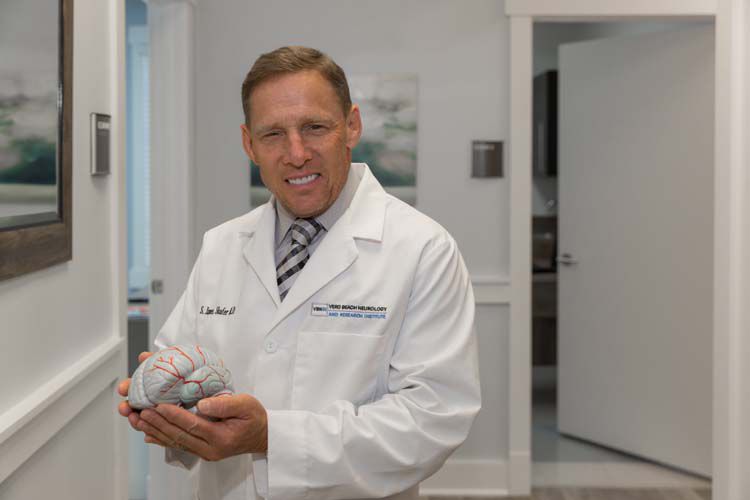
Researchers at the Washington University School of Medicine in St. Louis have developed a chemical compound that could potentially be used to detect Alzheimer’s disease in its earliest stages. We spoke to Vero Beach neurologist S. James Shafer about the significance of this finding.
Most people know that clusters of abnormal matter in the brain play a role in Alzheimer’s disease. These clusters, made of protein fragments, are called amyloid plaques and they build up between nerve cells. Amyloid plaques are classified as either compact or diffuse (more spread out).
Scientists have long known that compact amyloid plaques are associated with Alzheimer’s disease and there have been three compounds approved by the FDA in the last few years to detect their presence; these compounds are used in conjunction with imaging tests such as PET scans.
The prevailing belief has been that there is no relationship between diffuse plaques and the disease; however, the Washington University researchers believe that the diffuse plaque – which the compound they developed detects – may be an indicator of the earliest stages of Alzheimer’s.
Vero’s Dr. Shafer does not question this not-yet-approved compound, called fluselenamyl, detects diffuse amyloid plaques and says that imaging tests are valuable as an “adjunct” method of diagnosing Alzheimer’s. The Washington University research was conducted using brain slices of patients who had died of Alzheimer’s and other diseases. In addition to finding that fluselenamyl detected much smaller clumps of amyloid protein than did the three FDA-approved compounds, the study also showed another advantage – their new compound did not interact with the healthy “white matter” in the brain slices; such interaction can cause false positives.
As explained by Dr. Shafer, the evaluation to diagnose Alzheimer’s disease is multi-faceted. A full medical history is taken, and blood tests are conducted to see if there are any conditions – such as inflammation, infection or a thyroid deficiency – that might be causing the symptoms that caused the patient to seek help. An MRI of the brain can show tumors, nerve injury or bleeding. A formal cognitive assessment, using diagnostic tools designed to map mental function, may also be administered.
But before all of that, there is a simple discussion. Dr. Shafer says, “I’ll ask the patient ‘What is different today than it was a year ago? What can’t you do now that you could you do then?’ It’s really important for the spouse or caregiver to be part of this discussion, because sometimes the patient does not have a full awareness of what has changed.”
While many people think of memory loss as being an early sign of Alzheimer’s, Dr. Shafer says that is actually a later manifestation. “What is usually seen first is a problem with language; having trouble finding the right word to name something,” he says. This problem is called aphasia, a reduction in the brain’s ability to use and interpret language appropriately. In addition to not being able to come up with the right word, the person may also have trouble following and participating in conversations.
Another early indication of Alzheimer’s is a condition called apraxia – the inability to carry out a previously-learned motor activity (such as dressing or making a sandwich).
The level of impairment determined by the discussion and the tests drives the treatment options. And while early detection (which the Washington University researchers tout as an advantage of fluselenamyl) is key in most diseases, Dr. Shafer says it’s somewhat different with Alzheimer’s, as it’s a progressive disease – there are medications that can slow its progression, but it can’t be stopped. However, he does say that diagnosing Alzheimer’s early can be helpful for planning purposes regarding current lifestyle and care that will be needed in the long run.
What Dr. Shafer is really excited about is the possibility of compounds being developed that will help cure Alzheimer’s, rather than just diagnose it. “This is an area of research that is going to grow,” he says. “If we can develop compounds that devour and destroy amyloid plaques, that will be a really big deal.”
Dr. Shafer sees patients and conducts research at the Vero Beach Neurology and Research Institute, located at 1040 37th Place, Suite 201, in Vero Beach. The phone number is 772-492-7051.



